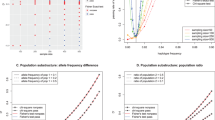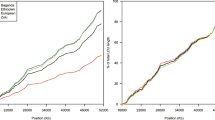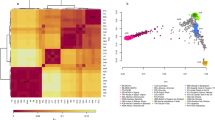Abstract
First generation linkage disequilibrium (LD) and haplotype maps of the human major histocompatibility complex (MHC) have been generated in order to aid the unraveling of the numerous disease predisposing genes in this region by offering a first set of haplotype tagSNPs. Several parameters, like the population studied, the marker map used, the density of polymorphisms and the applied algorithm, are influencing the appearance of haplotype blocks and selection of tags. The MHC comprises a limited number of ancestral, conserved haplotypes. We address the impact of the underlying HLA haplotypes on the LD patterns, haplotype blocks and tag selection throughout the entire extended MHC (xMHC) by studying DR-DQ haplotypes, mainly those carrying DRB1*03 and DRB1*04 alleles. We observed significantly different degree and extent of LD calculated on different HLA backgrounds, as well as variation in the size and boundaries of the defined haplotype and tags selected. Our results demonstrate that the underlying ancestral HLA haplotypic architecture is yet another parameter to take into consideration when constructing LD maps of the xMHC. This may be essential for mapping of disease susceptibility genes since many diseases are associated with and map on particular HLA haplotypes.
This is a preview of subscription content, access via your institution
Access options
Subscribe to this journal
Receive 6 digital issues and online access to articles
$119.00 per year
only $19.83 per issue
Buy this article
- Purchase on Springer Link
- Instant access to full article PDF
Prices may be subject to local taxes which are calculated during checkout




Similar content being viewed by others
References
Goldstein DB . Islands of linkage disequilibrium. Nat Genet 2001; 29: 109–111.
Nordborg M, Tavare S . Linkage disequilibrium: what history has to tell us. Trends Genet 2002; 18: 83–90.
Weiss KM, Clark AG . Linkage disequilibrium and the mapping of complex human traits. Trends Genet 2002; 18: 19–24.
Risch N, Merikangas K . The future of genetic studies of complex human diseases. Science 1996; 273: 1516–1517.
Lander ES, Schork NJ . Genetic dissection of complex traits. Science 1994; 265: 2037–2048.
Jorde LB . Linkage disequilibrium and the search for complex disease genes. Genome Res 2000; 10: 1435–1444.
Abecasis GR, Noguchi E, Heinzmann A, Traherne JA, Bhattacharyya S, Leaves NI et al. Extent and distribution of linkage disequilibrium in three genomic regions. Am J Hum Genet 2001; 68: 191–197.
Reich DE, Cargill M, Bolk S, Ireland J, Sabeti PC, Richter DJ et al. Linkage disequilibrium in the human genome. Nature 2001; 411: 199–204.
Stephens JC, Schneider JA, Tanguay DA, Choi J, Acharya T, Stanley SE et al. Haplotype variation and linkage disequilibrium in 313 human genes. Science 2001; 293: 489–493.
Ardlie KG, Kruglyak L, Seielstad M . Patterns of linkage disequilibrium in the human genome. Nat Rev Genet 2002; 3: 299–309.
Daly MJ, Rioux JD, Schaffner SF, Hudson TJ, Lander ES . High-resolution haplotype structure in the human genome. Nat Genet 2001; 29: 229–232.
Jeffreys AJ, Kauppi L, Neumann R . Intensely punctate meiotic recombination in the class II region of the major histocompatibility complex. Nat Genet 2001; 29: 217–222.
Patil N, Berno AJ, Hinds DA, Barrett WA, Doshi JM, Hacker CR et al. Blocks of limited haplotype diversity revealed by high-resolution scanning of human chromosome 21. Science 2001; 294: 1719–1723.
Gabriel SB, Schaffner SF, Nguyen H, Moore JM, Roy J, Blumenstiel B et al. The structure of haplotype blocks in the human genome. Science 2002; 296: 2225–2229.
Kauppi L, Sajantila A, Jeffreys AJ . Recombination hotspots rather than population history dominate linkage disequilibrium in the MHC class II region. Hum Mol Genet 2003; 12: 33–40.
Gibbs RA, Belmont JW, Hardenbol P, Willis TD, Yu F, Yang H et al. The International HapMap Project. Nature 2003; 426: 789–796.
Johnson GC, Esposito L, Barratt BJ, Smith AN, Heward J, Di GG et al. Haplotype tagging for the identification of common disease genes. Nat Genet 2001; 29: 233–237.
Schulze TG, Zhang K, Chen YS, Akula N, Sun F, McMahon FJ et al. Defining haplotype blocks and tag single-nucleotide polymorphisms in the human genome. Hum Mol Genet 2004; 13: 335–342.
Ke X, Hunt S, Tapper W, Lawrence R, Stavrides G, Ghori J et al. The impact of SNP density on fine-scale patterns of linkage disequilibrium. Hum Mol Genet 2004; 13: 577–588.
Cardon LR, Abecasis GR . Using haplotype blocks to map human complex trait loci. Trends Genet 2003; 19: 135–140.
Phillips MS, Lawrence R, Sachidanandam R, Morris AP, Balding DJ, Donaldson MA et al. Chromosome-wide distribution of haplotype blocks and the role of recombination hot spots. Nat Genet 2003; 33: 382–387.
Hafler DA, De Jager PL . Applying a new generation of genetic maps to understand human inflammatory disease. Nat Rev Immunol 2005; 5: 83–91.
The MHC sequencing consortium. Complete sequence and gene map of a human major histocompatibility complex. Nature 1999; 401: 921–923.
Horton R, Wilming L, Rand V, Lovering RC, Bruford EA, Khodiyar VK et al. Gene map of the extended human MHC. Nat Rev Genet 2004; 5: 889–899.
Thorsby E . HLA associated diseases. Hum Immunol 1997; 53: 1–11.
Degli-Esposti MA, Leaver AL, Christiansen FT, Witt CS, Abraham LJ, Dawkins RL et al. Ancestral haplotypes: conserved population MHC haplotypes. Hum Immunol 1992; 34: 242–252.
Alper CA, Awdeh Z, Yunis EJ . Conserved, extended MHC haplotypes. Exp Clin Immunogenet 1992; 9: 58–71.
Yunis EJ, Larsen CE, Fernandez-Vina M, Awdeh ZL, Romero T, Hansen JA et al. Inheritable variable sizes of DNA stretches in the human MHC: conserved extended haplotypes and their fragments or blocks. Tissue Antigens 2003; 62: 1–20.
Walsh EC, Mather KA, Schaffner SF, Farwell L, Daly MJ, Patterson N et al. An integrated haplotype map of the human major histocompatibility complex. Am J Hum Genet 2003; 73: 580–590.
Miretti MM, Walsh EC, Ke X, Delgado M, Griffiths M, Hunt S et al. A high-resolution linkage-disequilibrium map of the human major histocompatibility complex and first generation of tag single-nucleotide polymorphisms. Am J Hum Genet 2005; 76: 634–646.
Ahmad T, Neville M, Marshall SE, Armuzzi A, Mulcahy-Hawes K, Crawshaw J et al. Haplotype-specific linkage disequilibrium patterns define the genetic topography of the human MHC. Hum Mol Genet 2003; 12: 647–656.
Wall JD, Pritchard JK . Haplotype blocks and linkage disequilibrium in the human genome. Nat Rev Genet 2003; 4: 587–597.
Evans DM, Cardon LR . A comparison of linkage disequilibrium patterns and estimated population recombination rates across multiple populations. Am J Hum Genet 2005; 76: 681–687.
Stumpf MP . Haplotype diversity and SNP frequency dependence in the description of genetic variation. Eur J Hum Genet 2004.
Stenzel A, Lu T, Koch WA, Hampe J, Guenther SM, De La Vega FM et al. Patterns of linkage disequilibrium in the MHC region on human chromosome 6p. Hum Genet 2004; 114: 377–385.
Mueller JC, Lohmussaar E, Magi R, Remm M, Bettecken T, Lichtner P et al. Linkage disequilibrium patterns and tagSNP transferability among European populations. Am J Hum Genet 2005; 76: 387–398.
Gaudieri S, Leelayuwat C, Tay GK, Townend DC, Dawkins RL . The major histocompatability complex (MHC) contains conserved polymorphic genomic sequences that are shuffled by recombination to form ethnic-specific haplotypes. J Mol Evol 1997; 45: 17–23.
Gregersen PK, Kao H, Nunez-Roldan A, Hurley CK, Karr RW, Silver J et al. Recombination sites in the HLA class II region are haplotype dependent. J Immunol 1988; 141: 1365–1368.
Cullen M, Perfetto SP, Klitz W, Nelson G, Carrington M . High-resolution patterns of meiotic recombination across the human major histocompatibility complex. Am J Hum Genet 2002; 71: 759–776.
Thomsen M, Neugebauer M, Arnaud J, Borot N, Sevin A, Baur M et al. Recombination fractions in the HLA system based on the data set ‘provinces Francaises’: indications of haplotype-specific recombination rates. Eur J Immunogenet 1994; 21: 33–43.
Lindholm E, Zhang J, Hodge SE, Greenberg DA . The reliability of haplotyping inference in nuclear families: misassignment rates for SNPs and microsatellites. Hum Hered 2004; 57: 117–127.
Schulze TG, Chen YS, Akula N, Hennessy K, Badner JA, McInnis MG et al. Can long-range microsatellite data be used to predict short-range linkage disequilibrium? Hum Mol Genet 2002; 11: 1363–1372.
Herr M, Dudbridge F, Zavattari P, Cucca F, Guja C, March R et al. Evaluation of fine mapping strategies for a multifactorial disease locus: systematic linkage and association analysis of IDDM1 in the HLA region on chromosome 6p21. Hum Mol Genet 2000; 9: 1291–1301.
Eskdale J, Keijsers V, Huizinga T, Gallagher G . Microsatellite alleles and single nucleotide polymorphisms (SNP) combine to form four major haplotype families at the human interleukin-10 (IL-10) locus. Genes Immun 1999; 1: 151–155.
Undlien DE, Lie BA, Thorsby E . HLA complex genes in type 1 diabetes and other autoimmune diseases. Which genes are involved? Trends in Genetics 2001; 17: 93–100.
van den Oord EJ, Neale BM . Will haplotype maps be useful for finding genes? Mol Psychiatry 2004; 9: 227–236.
Lai E, Bowman C, Bansal A, Hughes A, Mosteller M, Roses AD et al. Medical applications of haplotype-based SNP maps: learning to walk before we run. Nat Genet 2002; 32: 353.
Lie BA, Todd JA, Pociot F, Nerup J, Akselsen HE, Joner G et al. The predisposition to type 1 diabetes linked to the human leukocyte antigen complex includes at least one non-class II gene. Am J Hum Genet 1999; 64: 793–800.
Johansson S, Lie BA, Todd JA, Pociot F, Nerup J, Cambon-Thomsen A et al. Evidence of at least two type 1 diabetes susceptibility genes distinct from HLA-DQB1, -DQA1 and -DRB1. Genes Immun 2003; 4: 46–53.
Johansson S, Lie BA, Cambon-Thomsen A, Pociot F, Nerup J, Kockum I et al. No evidence of type 1 diabetes susceptibility genes in the region centromeric of the HLA complex. Hum Immunol 2003; 64: 951–959.
Lie BA, Undlien D, Thorsby E . The genetics of disease suseceptibility: strategies for analyzing polygenic HLA associations using microsatellite markers. In: Genomic Analysis of the Human MHC IHWG Tecnical Manual. Marcel Tilanus, 2000.
O’Connell JR, Weeks DE . PedCheck: a program for identification of genotype incompatibilities in linkage analysis. Am J Hum Genet 1998; 63: 259–266.
Becker T, Knapp M . Maximum-likelihood estimation of haplotype frequencies in nuclear families. Genet Epidemiol 2004; 27: 21–32.
Slatkin M, Excoffier L . Testing for linkage disequilibrium in genotypic data using the Expectation-Maximization algorithm. Heredity 1996; 76 (Part 4): 377–383.
Undlien DE, Friede T, Rammensee HG, Joner G, Dahl-Jørgensen K, Søvik O et al. HLA encoded genetic predisposition in insulin-dependent diabetes mellitus (IDDM). DR4 subtypes may be associated with different degrees of protection. Diabetes 1997; 46: 143–149.
Grimaldi MC, Clayton J, Pontarotti P, Cambon-Thomsen A, Crouau-Roy B . New highly polymorphic microsatellite marker in linkage disequilibrium with HLA-B. Hum Immunol 1996; 51: 89–94.
Price P, Witt C, Allcock R, Sayer D, Garlepp M, Kok CC et al. The genetic basis for the association of the 8.1 ancestral haplotype (A1, B8, DR3) with multiple immunopathological diseases. Immunol Rev 1999; 167: 257–274.
Hedrick PW . Gametic disequilibrium measures: proceed with caution. Genetics 1987; 117: 331–341.
Zhang K, Deng M, Chen T, Waterman MS, Sun F . A dynamic programming algorithm for haplotype block partitioning. Proc Natl Acad Sci USA 2002; 99: 7335–7339.
Acknowledgements
This study was supported by the Juvenile Diabetes Research Foundation International (1-2004-793, 1-2000-514, 1-2000-515), the University of Oslo, The Functional Genomics program (FUGE), the Norwegian Research Council, the Norwegian Diabetes Association, the NovoNordisk Foundation, Eastern Norway Regional Health Authority and the Swedish Foundation for Strategic Research (1999/0211). We thank the Norwegian Study Group for childhood Diabetes, the Danish Study Group of Diabetes in Childhood, the Danish IDDM Epidemiology and Genetics Group, the Swedish Childhood Diabetes Study, the Diabetes Incidence Study in Sweden, the French Network Inserm for IDDM and MS in Atlantic Pyrenees (Dr A Cambon-Thomsen) and the Regional Observatory of health in Aquitaine region (Dr J Doutreix) for the collection of samples used in this study. We also thank Dr K Zhang for making the HapBlock program available for multiallelic markers.
Author information
Authors and Affiliations
Corresponding author
Rights and permissions
About this article
Cite this article
Blomhoff, A., Olsson, M., Johansson, S. et al. Linkage disequilibrium and haplotype blocks in the MHC vary in an HLA haplotype specific manner assessed mainly by DRB1*03 and DRB1*04 haplotypes. Genes Immun 7, 130–140 (2006). https://doi.org/10.1038/sj.gene.6364272
Received:
Revised:
Accepted:
Published:
Issue Date:
DOI: https://doi.org/10.1038/sj.gene.6364272
Keywords
This article is cited by
-
Predicting the molecular mechanism-driven progression of breast cancer through comprehensive network pharmacology and molecular docking approach
Scientific Reports (2023)
-
Identification, analysis of deleterious SNPs of the human GSR gene and their effects on the structure and functions of associated proteins and other diseases
Scientific Reports (2022)
-
Genetics of primary sclerosing cholangitis and pathophysiological implications
Nature Reviews Gastroenterology & Hepatology (2017)
-
Population-specific recombination sites within the human MHC region
Heredity (2013)
-
Conditional analyses on the T1DGC MHC dataset: novel associations with type 1 diabetes around HLA-G and confirmation of HLA-B
Genes & Immunity (2009)



